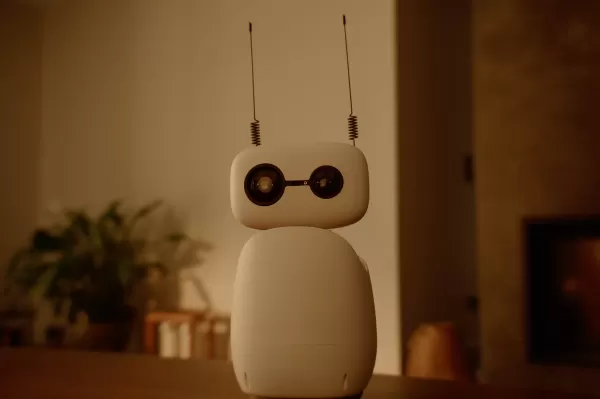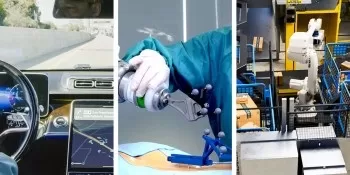Tera AI Emerges from Stealth with $7.8M for Robot Visual Navigation

Robots are pushing the boundaries of technology, but they face some big hurdles. They depend heavily on a mix of sensors, external signals like GPS and Wi-Fi, and specialized software just to get around. Plus, many robots use pricey, off-the-shelf hardware that comes with its own software and sensors tailored for specific jobs, like figuring out how they're moving. This setup needs a lot of tweaking to work right and often only fits certain situations.
Because of all this, most robots today can't switch between different places easily, and only a tiny fraction of self-driving systems use AI to find their way.
But Tony Zhang, the founder and CEO of Tera AI, believes he's got a solution. His company is working on something called zero-shot navigation for robots, and investors are backing him up with a hefty $7.8 million in seed funding.
In simple terms, Tera AI is developing a spatial reasoning AI system that can help robots navigate on the cheap. This tech can be used for all sorts of things, like moving objects, mobile robots, and even self-driving cars.
"We're all about software that can be updated over the air and works with any robot that's already got a camera and a GPU," Zhang told TechCrunch. "Our system is inspired by how the brain works and can adapt to new situations on the fly, kind of like a big language model."
Zhang started Tera in San Francisco in 2023 after working on machine learning at Google X. He got his PhD at Caltech under Pietro Perona, a big name in computer vision who looked at how living things navigate in a flexible way.
Tera's team is made up of AI and simulation experts from Google AI, Caltech, MIT, and even the European Space Agency.
While everyone else is chasing after language models, Zhang and his team are focusing on teaching AI to understand space. This kind of spatial reasoning lets machines move around, spot objects, and interact with the world in 3D. By getting rid of hardware limits, their general-purpose navigation software could cut costs and speed up deployment by a huge amount, making robots way more useful, Zhang says.
"It could also unlock new tricks for robots that were stuck because of sensor limits," he added.
For example, a Waymo car might splash out $250,000, which includes a $50,000 sensor for pinpointing its location and a $100,000 lidar system. But smaller robots that cost less than $50,000 need cheaper ways to navigate on their own, according to Tera AI. A fancy GPS receiver can set you back $10,000, and a top-notch IMU (Inertial Measurement Unit) might hit $30,000 — prices that make autonomous navigation a no-go for many smaller robots.
"Our big selling point is that our software works with any hardware out there," Zhang said. "We're solving navigation in a way that works for any robot, in any new place, without needing to adjust it every time. It's like an operating system for robots, letting them do what they're meant to do and keep their customers happy."
The startup has been testing its product with major U.S. robotics companies. Their main customers are robot makers who already have a customer base but struggle to adapt their solutions to different autonomous platforms, situations, and environments.
With the new funding, Tera plans to roll out its first solution on small devices this year and beef up its tech team.
"We see a future where software is the star of the show for robots," Zhang told TechCrunch. "Once people realize that the cameras already on robots are enough for navigation, they'll be able to put more robots to work faster and cheaper. We're dreaming of a day where, just like with an iOS app store, you can add new skills to your robot with a simple download."
Tera's seed round was backed by investors like Felicis, Inovia, Caltech, Wilson Hill, and Naval Ravikant.
> SoftBank to invest $500M in robotics startup Skild AI
Related article
 Hugging Face Launches Pre-Orders for Reachy Mini Desktop Robots
Hugging Face invites developers to explore its latest robotics innovation.The AI platform announced Wednesday that it’s now accepting pre-orders for its Reachy Mini desktop robots. The company first s
Hugging Face Launches Pre-Orders for Reachy Mini Desktop Robots
Hugging Face invites developers to explore its latest robotics innovation.The AI platform announced Wednesday that it’s now accepting pre-orders for its Reachy Mini desktop robots. The company first s
 Nvidia charges ahead with humanoid robotics aided by the cloud
Nvidia is charging full speed ahead into the realm of humanoid robotics, and they're not holding back. At the Computex 2025 trade show in Taiwan, they unveiled a series of innovati
Nvidia charges ahead with humanoid robotics aided by the cloud
Nvidia is charging full speed ahead into the realm of humanoid robotics, and they're not holding back. At the Computex 2025 trade show in Taiwan, they unveiled a series of innovati
 Top 5 Autonomous Robots for Construction Sites in April 2025
The construction industry is undergoing a remarkable transformation, driven by the rise of robotics and automation. With the global market for construction robots projected to reach $3.5 billion by 2030, these innovations are revolutionizing safety and efficiency on job sites. From autonomous pile d
Comments (37)
0/200
Top 5 Autonomous Robots for Construction Sites in April 2025
The construction industry is undergoing a remarkable transformation, driven by the rise of robotics and automation. With the global market for construction robots projected to reach $3.5 billion by 2030, these innovations are revolutionizing safety and efficiency on job sites. From autonomous pile d
Comments (37)
0/200
![PaulTaylor]() PaulTaylor
PaulTaylor
 August 29, 2025 at 10:30:37 AM EDT
August 29, 2025 at 10:30:37 AM EDT
¿$7.8 millones para navegación visual de robots? Suena interesante, pero espero que no sea otra startup que promete demasiado y cumple poco 🤨. A ver si realmente logran romper con la dependencia del GPS y hardware caro. ¡Mucha suerte a Tera AI!


 0
0
![GaryJones]() GaryJones
GaryJones
 July 27, 2025 at 9:20:21 PM EDT
July 27, 2025 at 9:20:21 PM EDT
Wow, $7.8M for robot visual navigation? That's a hefty bet on Tera AI! I'm curious if their tech can really make robots smarter and ditch those clunky sensors. Fingers crossed it’s a game-changer! 🤖


 0
0
![EricRoberts]() EricRoberts
EricRoberts
 April 18, 2025 at 10:21:07 PM EDT
April 18, 2025 at 10:21:07 PM EDT
テラAIのロボットナビゲーションの新しいアプローチはすごい!たった780万ドルで大きなナビゲーションの問題に取り組むなんて。ただ、全員に手頃な価格になるかはわからないけど。これからの展開が楽しみだね!🚀


 0
0
![CharlesJohnson]() CharlesJohnson
CharlesJohnson
 April 18, 2025 at 1:12:06 PM EDT
April 18, 2025 at 1:12:06 PM EDT
¡El nuevo enfoque de Tera AI para la navegación de robots es genial! Es increíble cómo están abordando esos grandes problemas de navegación con solo 7.8 millones de dólares. Lo único es que no estoy seguro de si será asequible para todos. ¡Aun así, emocionado de ver a dónde va esto! 🚀


 0
0
![FrankSmith]() FrankSmith
FrankSmith
 April 17, 2025 at 7:47:59 AM EDT
April 17, 2025 at 7:47:59 AM EDT
¡El enfoque de Tera AI para la navegación de robots es bastante genial! No depender más de tantos sensores y GPS es un cambio de juego. Pero, tengo que decir, los costos de hardware todavía son un poco altos. ¿Alguien más piensa que es hora de opciones más asequibles? 🤔


 0
0
![GaryWalker]() GaryWalker
GaryWalker
 April 14, 2025 at 4:16:51 AM EDT
April 14, 2025 at 4:16:51 AM EDT
テラAIのロボットナビゲーションは革新的ですね!センサーやGPSに依存しないのはすごい進歩です。ただ、ハードウェアのコストがまだ高いのは気になります。もっと手頃な価格の選択肢が出てくるといいですね!😊


 0
0

 Hugging Face Launches Pre-Orders for Reachy Mini Desktop Robots
Hugging Face invites developers to explore its latest robotics innovation.The AI platform announced Wednesday that it’s now accepting pre-orders for its Reachy Mini desktop robots. The company first s
Hugging Face Launches Pre-Orders for Reachy Mini Desktop Robots
Hugging Face invites developers to explore its latest robotics innovation.The AI platform announced Wednesday that it’s now accepting pre-orders for its Reachy Mini desktop robots. The company first s
 Nvidia charges ahead with humanoid robotics aided by the cloud
Nvidia is charging full speed ahead into the realm of humanoid robotics, and they're not holding back. At the Computex 2025 trade show in Taiwan, they unveiled a series of innovati
Nvidia charges ahead with humanoid robotics aided by the cloud
Nvidia is charging full speed ahead into the realm of humanoid robotics, and they're not holding back. At the Computex 2025 trade show in Taiwan, they unveiled a series of innovati
 Top 5 Autonomous Robots for Construction Sites in April 2025
The construction industry is undergoing a remarkable transformation, driven by the rise of robotics and automation. With the global market for construction robots projected to reach $3.5 billion by 2030, these innovations are revolutionizing safety and efficiency on job sites. From autonomous pile d
Top 5 Autonomous Robots for Construction Sites in April 2025
The construction industry is undergoing a remarkable transformation, driven by the rise of robotics and automation. With the global market for construction robots projected to reach $3.5 billion by 2030, these innovations are revolutionizing safety and efficiency on job sites. From autonomous pile d
 August 29, 2025 at 10:30:37 AM EDT
August 29, 2025 at 10:30:37 AM EDT
¿$7.8 millones para navegación visual de robots? Suena interesante, pero espero que no sea otra startup que promete demasiado y cumple poco 🤨. A ver si realmente logran romper con la dependencia del GPS y hardware caro. ¡Mucha suerte a Tera AI!


 0
0
 July 27, 2025 at 9:20:21 PM EDT
July 27, 2025 at 9:20:21 PM EDT
Wow, $7.8M for robot visual navigation? That's a hefty bet on Tera AI! I'm curious if their tech can really make robots smarter and ditch those clunky sensors. Fingers crossed it’s a game-changer! 🤖


 0
0
 April 18, 2025 at 10:21:07 PM EDT
April 18, 2025 at 10:21:07 PM EDT
テラAIのロボットナビゲーションの新しいアプローチはすごい!たった780万ドルで大きなナビゲーションの問題に取り組むなんて。ただ、全員に手頃な価格になるかはわからないけど。これからの展開が楽しみだね!🚀


 0
0
 April 18, 2025 at 1:12:06 PM EDT
April 18, 2025 at 1:12:06 PM EDT
¡El nuevo enfoque de Tera AI para la navegación de robots es genial! Es increíble cómo están abordando esos grandes problemas de navegación con solo 7.8 millones de dólares. Lo único es que no estoy seguro de si será asequible para todos. ¡Aun así, emocionado de ver a dónde va esto! 🚀


 0
0
 April 17, 2025 at 7:47:59 AM EDT
April 17, 2025 at 7:47:59 AM EDT
¡El enfoque de Tera AI para la navegación de robots es bastante genial! No depender más de tantos sensores y GPS es un cambio de juego. Pero, tengo que decir, los costos de hardware todavía son un poco altos. ¿Alguien más piensa que es hora de opciones más asequibles? 🤔


 0
0
 April 14, 2025 at 4:16:51 AM EDT
April 14, 2025 at 4:16:51 AM EDT
テラAIのロボットナビゲーションは革新的ですね!センサーやGPSに依存しないのはすごい進歩です。ただ、ハードウェアのコストがまだ高いのは気になります。もっと手頃な価格の選択肢が出てくるといいですね!😊


 0
0





























